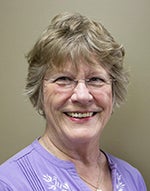What are abstract artists thinking? Try to see it
Published 9:00 am Saturday, March 16, 2019
Art is by Bev Jackson Cotter
Bev Jackson Cotter is a member of the Albert Lea Art Center, 101 S. Broadway, where the Merna Sunde Show will be on display through March 23.
“He who bites into a single mustard seed knows more about its taste than one who looks at an elephant load of mustard seeds.” I believe this is an ancient Indian proverb from the part of Asia where mustard and elephants abound.
“He who paints an abstract piece of art understands it better than one who looks at galleries of abstract pieces.” Modern proverb by me.
Have you ever stood in an art gallery and wondered what on earth the artist was thinking?
With the current showing at the Albert Lea Art Center, we are getting lots of those comments.
Merna Sunde’s exhibition is about as off the wall as we get, and it’s wonderful. Brilliant colors, haphazard lines, undefined shapes all combine to make some of the most unusual art we have ever displayed and our visitors are reacting.
“What on earth was she thinking?” “What is that supposed to be?” “Why would she paint something that looks like that?”

Bev Jackson Cotter
Her work is wonderful, and well worth taking a few moments of your time to visit and enjoy.
So, what is abstract art? “The Oxford Companion to Art,” edited by Harold Osborne, defines this art form developed during and following World War II as “…free in technique, tending to stimulate vision rather than gratify established conventions of good taste.”
Gerhard Gollwitzer has other ideas. His book “Abstract Art, How to Draw and Understand It” begins by saying, “Whoever bites into a single seed of art knows more about it than someone who looks at a load of reproductions and reads a load of art books.” In other words, you learn by doing.
He goes on to suggest you take a blank piece of paper and a pencil, then draw a circle, not with a compass, that is too exact and has no life. Draw your circle free hand and then go over it several times, each circle will look a little different. Your paper already has an energy that wasn’t there before. Then draw more circles, inside, outside, over each other, near each other.
You’ve created a drawing that is original, unique, and only you.
Do the same thing with lines, horizontal, vertical, diagonal, squares, rectangles, short lines, long lines, jagged lines, smooth lines. The possibilities are limitless. Horizontal lines look peaceful, vertical lines look dignified, diagonal lines are exciting. Connect them, draw around them, overlap them.
You will find that your rounded lines are more gentle and the straight lines more rigid. You are creating a mood. When you add color, even more exciting things take place. Color lends feeling — red meaning danger or excitement, blue signifying peace, yellow defining cheerfulness and joy.
You are already learning to appreciate abstract art. You do not have a particular subject in mind, yet you will find that a series of lines reminds you of something. Suddenly the drawing has meaning.
Back to the art of Merna Sunde. She had the amazing ability to do photographically real drawings, but I believe she had more fun creating moods, happy, sad, scary. Her use of brilliant colors added more emotion to her paintings, and if you take the time to study them, you will be surprised to learn how much thought went into each of her pieces.
Her show is only up until March 23, so do stop in and enjoy.
Meanwhile, pull out a blank piece of paper and draw some circles. Maybe use colored pencils so you can see which ones move forward on your paper and which ones recede. Fill in some of the circles and leave others blank. Fill some with squiggly lines and others with flower petals.
You are not trying to draw a photographically real design. You are just having fun.
Is abstract art stimulating or confusing or boring? Do you understand it? Try it, then decide.

